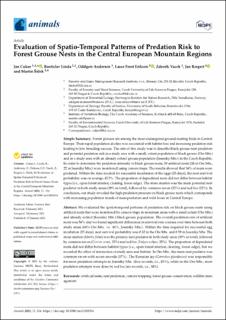Evaluation of Spatio-Temporal Patterns of Predation Risk to Forest Grouse Nests in the Central European Mountain Regions
Cukor, Jan; Linda, Rostislav; Andersen, Oddgeir; Eriksen, Lasse Frost; Vacek, Zdenek; Riegert, Jan; Salek, Martin
Peer reviewed, Journal article
Published version

View/
Date
2021Metadata
Show full item recordCollections
- Publikasjoner fra CRIStin - NINA [2397]
- Scientific publications [1423]
Abstract
We evaluated the spatiotemporal patterns of predation risk on black grouse nests using
artificial nests that were monitored by camera traps in mountain areas with a small extant (Ore Mts.)
and already extinct (Jeseníky Mts.) black grouse population. The overall predation rate of artificial
nests was 56% and we found significant differences in survival rate courses over time between both
study areas (68% Ore Mts. vs. 41%, Jeseníky Mts.). Within the time required for successful egg
incubation (25 days), nest survival probability was 0.32 in the Ore Mts. and 0.59 in Jeseníky Mts. The
stone marten (Martes foina) was the primary nest predator in both study areas (39% in total), followed
by common raven (Corvus corax, 25%) and red fox (Vulpes vulpes, 22%). The proportion of depredated
nests did not differ between habitat types (i.e., open forest interior, clearing, forest edge), but we
recorded the effect of interaction of study area and habitat. In Ore Mts., the main nest predator was
common raven with seven records (37%). The Eurasian jay (Garrulus glandarius) was responsible
for most predation attempts in Jeseníky Mts. (five records, i.e., 83%), while in the Ore Mts., most
predation attempts were done by red fox (six records, i.e., 38%
